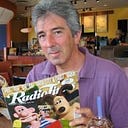Member-only story
How Television Reported the Pearl Harbor Attack

On December 7, 1941, the “date which will live in infamy,” Japan attacked the Pearl Harbor naval base in Hawaii, and several other Pacific islands, a few minutes before 8:00 a.m. local time, 2:00 p.m. Eastern time. Recordings of radio’s breaking coverage can be found online today, eighty years later. But most people don’t realize that television had been around just long enough, even at that early date, to cover the news as quickly as possible.
In New York, local radio station WOR and the radio network affiliates of CBS and NBC all interrupted their broadcasts with the bulletin off the wire services; they all did so between 2:26 and 2:30 p.m.
It’s been estimated that there were still fewer than 10,000 TV sets in the entire country at the time, and half of those were in New York, where were only two commercial TV stations operating, WNBT (NBC) and WCBW (CBS). This was only five months after the FCC issued the first commercial licenses for television on July 1. DuMont’s station W2XWV was still experimental, and not yet licensed.
On December 7, only WNBT was on the air, as WCBW did not broadcast on Sundays. When the WNBT newsroom teletypes first received the bulletins of the Pearl Harbor attack, the station had just begun running the film Millionaire Playboy, starring radio comedian Joe Penner. Shortly after 3:30 p.m., station announcer Ray Forrest interrupted the film with the news. Sam Cuff, host of the station’s Face of the War program, had at his disposal a number of maps to help illustrate the nature and location of the attack. One studio camera was pointed at the Associated Press teletype to capture the moment of each new bulletin’s arrival. Cuff was eventually joined by his Face of the War colleagues to analyze the incoming information.
Meanwhile, with WCBW off the air, that station’s news writer Robert Skedgell, news reader Richard Hubbell, and program director Gilbert Seldes heard the news and scrambled to get from their homes to the station and unlock its doors. Skedgell and Hubbell had been collaborators on the station’s 15-minute weekday news broadcasts, and by 3:30 p.m., WCBW was on the air with its first reports, right on the heels of WNBT. And, like their competitor, they had to rely on maps of the Pacific and sporadic updates throughout the day, but…
